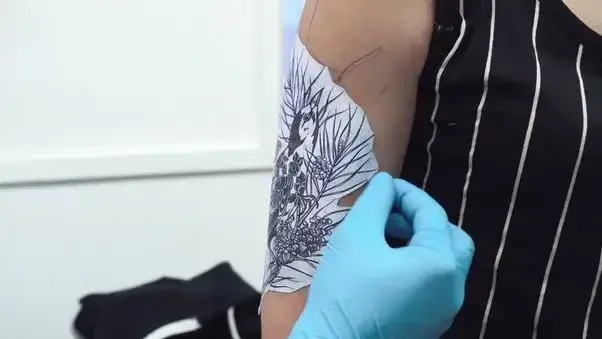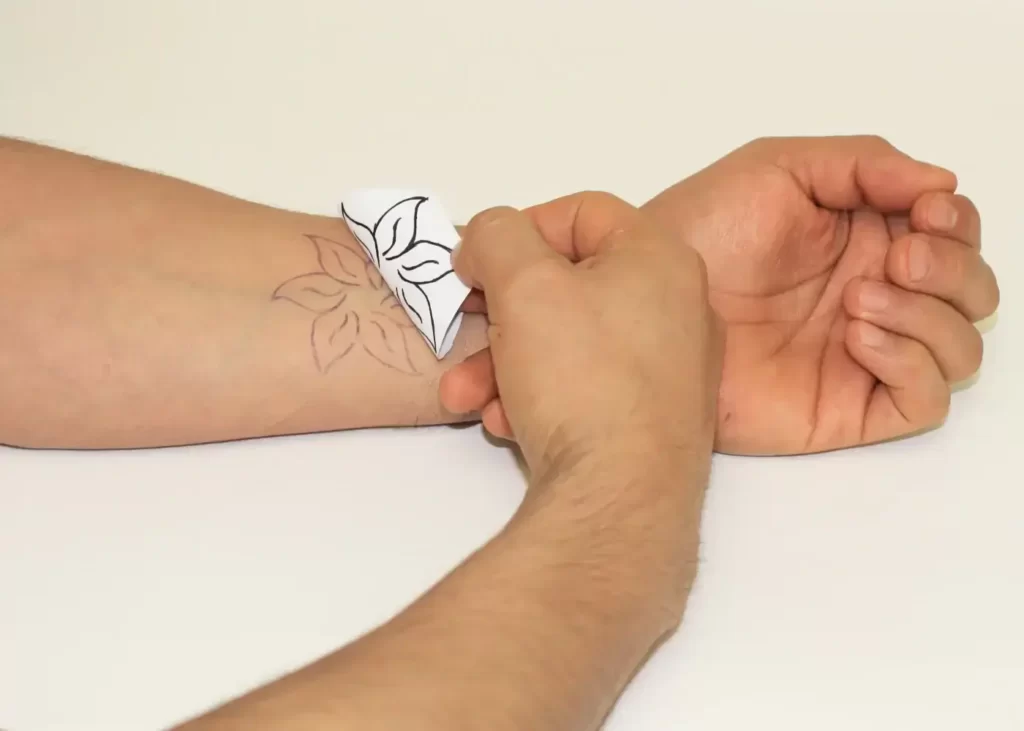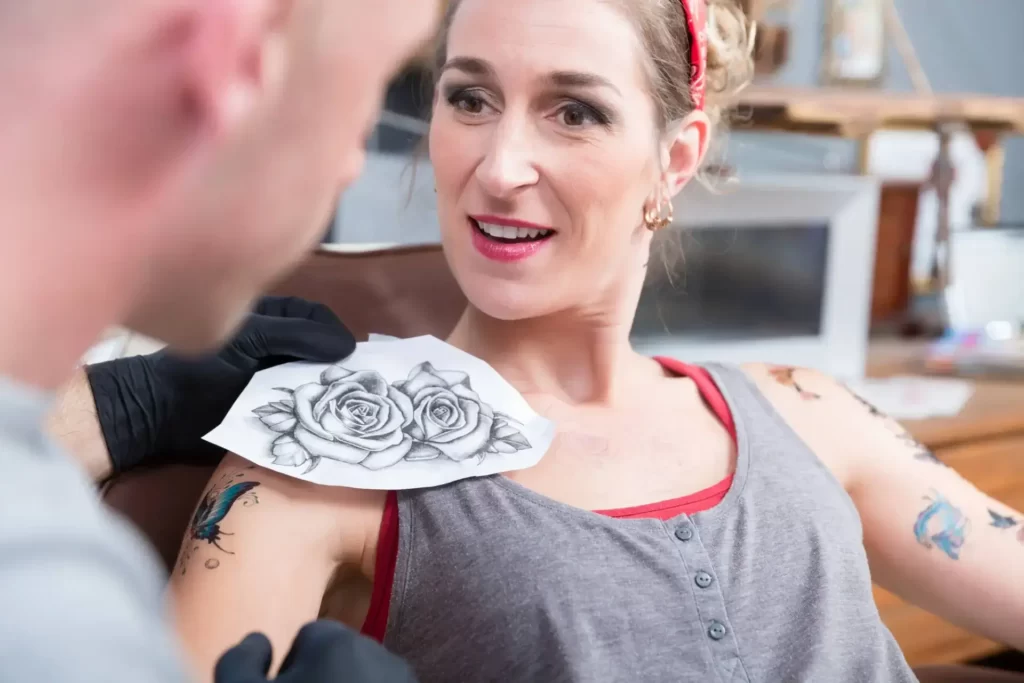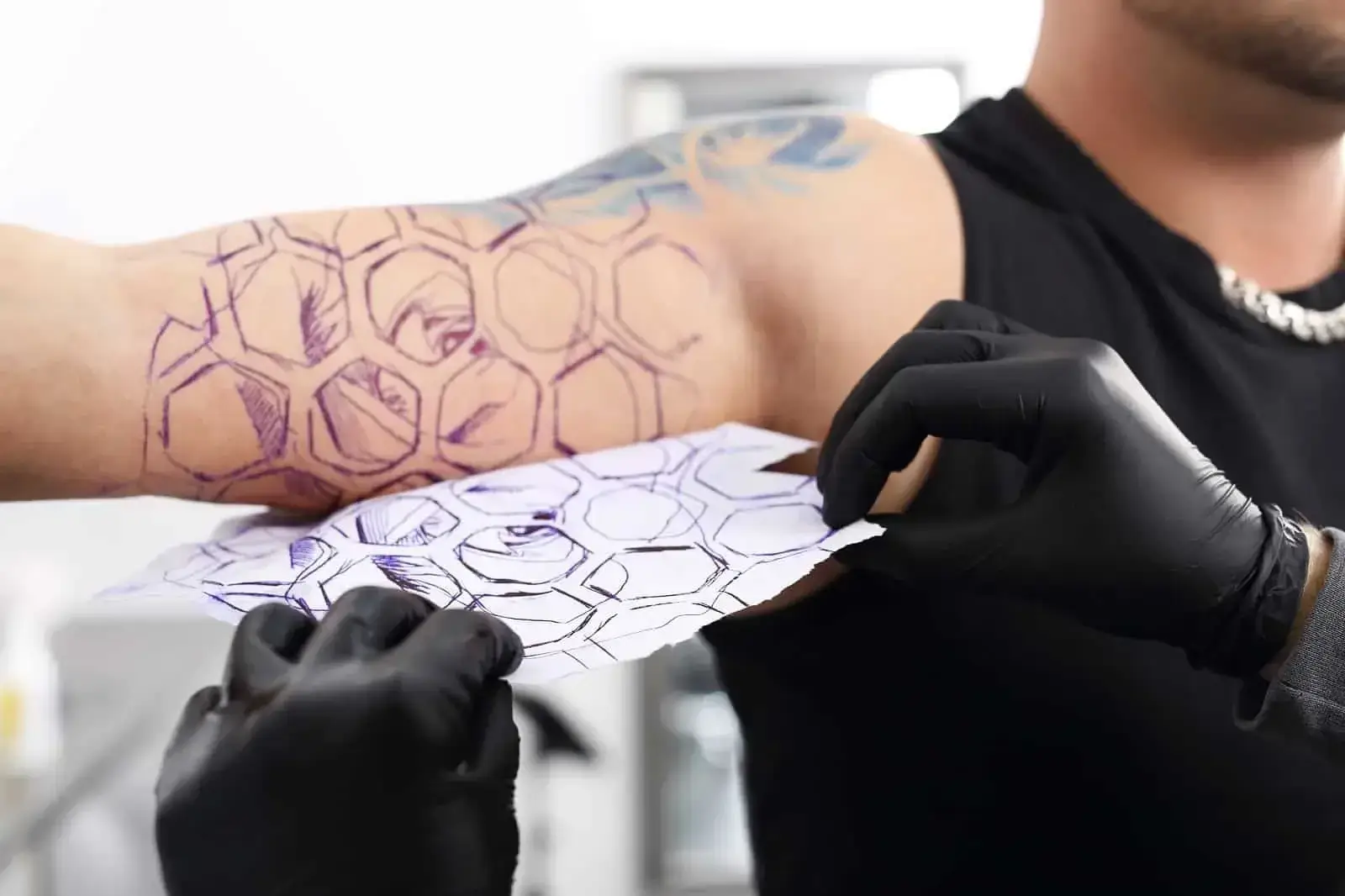Are you looking for an effective way to remove that temporary tattoo stencil from your skin?
Removing a tattoo stencil can be a difficult and tricky process, but fear not, I’m here to share some methods that can make this task much easier and leave your skin undamaged.
In this blog post, I’ll guide you on how to remove tattoo stencil at home without any hassle.
Also Read: Calf Tattoo Hurts To Walk? Discover Proven Strategies For Pain-Free Steps
What Is A Tattoo Stencil Applied By A Tattoo Artist?
A tattoo stencil serves as a crucial tool for tattoo artists. Before they apply tattoos, these stencils, often made of paper, hold the design or pattern to be transferred onto the skin.
The artists usually draw the desired artwork on tissue or carbon paper. Some may use a special printer for a more perfect and satisfied outcome.
The transfer is then placed directly onto the skin, creating a temporary guideline. This professional approach can use various mediums like ink, airbrush, or needle and machine.
The type of application and process depends on the artist, ensuring a precise and accurate outlining of lines.
This practice reduces the need for freehand drawing, providing guidance and minimizing mistakes during the inking phase.
Now, let’s focus on removing these stencils. From my experience, the process is surprisingly straightforward.
Once the tattoo is complete and you’re satisfied with the artwork, it’s time to remove the stencil. This can be done using a mild soap and warm water.
Gently wash the area with a soft cloth, ensuring not to scrub harshly. The stencil markings, which were crucial during the tattoo process for precise application, will wash away, leaving behind the beautiful, permanent tattoo.
Remember, while the stencil is vital for creating the tattoo, its removal is equally important to reveal the final artwork.
The stencil’s role is to guide the artist, ensuring they apply the tattoo ink with precision and accuracy, especially when outlining and transferring the design.
Once its job is done, washing it away unveils the true beauty of your tattoo.
Also Read: How Soon After Laparoscopic Surgery Can I Get A Tattoo
Why Do Tattoo Artists Use Stencils?
Tattoo artists use stencils for a variety of reasons, primarily to ensure the placement and line work of a tattoo is exact and intended as per the design.
A stencil acts like a template, which artists trace onto the skin. These can be reusable or disposable and are essential in laying down the initial structure of the tattoo.
By using a stencil, artists avoid making errors and save precious time. It’s a method that offers a clear guide, especially for intricate designs, compared to the freehand draw method used when starting.
Now, when it comes to removing these stencils, the process is simple yet crucial. Once the permanent ink is injected, the temporary stencil’s job is done.
To remove it, gently clean the area with a mild soap and water. This step is important to reveal the clean, permanent artwork underneath.
Remember, the stencil is a temporary guide, essential for the artist to trace the design accurately.
After the tattoo is completed, its removal is vital to showcase the clean lines and detailed work that has been permanently etched into the skin.
Also Read: Can You Get A Tattoo On Accutane

Types Of Stencil Papers
In tattooing, types of stencil papers include hectograph and thermal paper, essential for transferring designs onto skin.
1. Hectograph Stencil Paper
Hectograph stencil paper is a unique tattoo transfer medium used by artists to transfer designs onto the skin.
It consists of three layers: the top layer where the artist draws the design, the middle layer to prevent the sheets from sticking together, and the bottom layer, which is the stencil itself.
This paper is coated with a waxy substance, ideal for transferring detailed designs. The main advantage of hectograph paper is that it’s inexpensive and requires no more than a special pencil or pen to create the transfer.
When it comes to removing the stencil, care must be taken to ensure the design has been transferred properly. Once the tattooing process is complete, gentle cleaning will remove the hectograph markings, revealing the finished tattoo.
This inexpensive and traditional method offers tattoo artists a reliable way to preview and perfect their designs on the skin before inking.
2. Thermal Stencil Paper
Thermal stencil paper is a popular choice among tattoo artists for its efficiency in transferring designs.
This type of paper works with a thermal transfer printer, utilizing heat-activated adhesive and a backing that keeps the paper stable during the transfer process.
It consists of four layers: the top layer is white and is where the design gets printed; the middle layer is thin and is removed once the ink is applied; a yellow layer beneath holds the design; and the bottom layer is protective.
The sticky side of the yellow layer is what sticks to the surface of the skin when pressure is applied.
Removing a thermal stencil is straightforward. After the design is applied and the tattooing is completed, the thermal paper’s remnants can be easily wiped away with a gentle cleanser, revealing the clean lines of the new tattoo.
This popular and modern method ensures a high level of precision and is an essential step in the tattooing process, allowing for accurate placement and detailing in the artwork.
Also Read: Is Dermasil Good For Tattoos
How Long Does It Take To Do A Tattoo Design Stencil?
Creating a tattoo design stencil is an important step in the tattooing process. The time it takes can vary greatly, generally ranging from 30 minutes to one hour.
This timeframe depends on factors like the complexity and size of the design. The quality and type of stencil paper used also play a role.
Commonly, hectograph paper is used, which is specially designed and coated with wax. The design is drawn with pencils or markers and then transferred to the skin.
For today’s tattoos, which are often detailed and complex, it may take less time to use a pre-made template. However, hand-drawn stencils, while risky, ensure a more precise and individualized design.
Factors like manufacturing differences, the size and shape of body parts, and the style and level of detail desired in the tattoo all influence the time needed to create a stencil.
In some cases, an artist might choose to freehand a design directly on the skin, adding about 15 minutes to the existing time frame.
This method is often used for completing a design in a unique style or detail level. Whether using a mock-up or freehanding, the stencil creation process is crucial for visualizing the final tattoo.
Once the stencil is in place and the tattooing begins, the focus shifts to completing the design.
Removing the stencil afterward is straightforward, involving gentle cleansing to reveal the desired artwork.
Also Read: Is Dove Soap Good For Tattoos
Benefits Of Having Tattoo Stencils Applied To The Skin
Having tattoo stencils applied to the skin offers numerous benefits. It’s an easy and efficient way for artists to create even the most intricate designs.
Stencils provide pre-made, detailed outlines of the desired artwork, which can be precisely transferred onto the body.
This is particularly advantageous for larger, more detailed tattoos, where accuracy in size and placement is critical.
The use of stencils eliminates guesswork, saving time and stress for both the artist and the client.
Another key benefit is the clarity it brings to the tattoo process. Colors appear cleaner, and there’s a better look during the healing phase.
Clean outlines enhance the visibility of the design, especially on varying flesh tones.
When blended with the application of ink, stencils help maintain uniformity and sharper, more professional elements in the final tattoo.
Once the tattoo is completed, removing the stencil is straightforward, revealing the clean, professional-looking tattoo underneath.
The stencil’s role in ensuring the accuracy and clarity of the tattoo is pivotal, greatly contributing to the overall quality and appearance of the finished artwork.
Also Read: Why Tattoo Lines Thicker After Healing Demystified
How Long Do Tattoo Stencils Last For?
How long tattoo stencils last may not seem like the most important aspect of tattooing, but it’s essential.
The staying power of a stencil, whether it’s made from paper or hand-drawn with ink, hinges on quality and how correctly it’s applied. Achieving the best results from a tattoo starts with a durable stencil.
Typically speaking, depending on the condition of the client’s skin and the stencil’s exposure to water and friction from clothing, a stencil can last from a few days to several weeks.
It’s unrealistic to expect them to last forever; fading or smudging can occur faster than expected due to these factors.
The amount of detail in a drawing and the type of ink used in designs can influence how quickly they fade.
Environmental elements, such as sun and water, and the necessity to keep our bodies clean with soap, also play a role in the lifespan of a stencil.
Ultimately, while stencils are a temporary guide for the tattoo artist, understanding their durability helps in planning the tattooing process and in preparing for the timely removal of the stencil to reveal the final artwork.
Also Read: Stay Calm And Follow These Steps If You Have Accidentally Ripped Off Tattoo Scab

How Are Tattoo Stencils Applied?
Tattoo stencils are applied in steps that are crucial for the success of the tattoo.
1. Creating The Design For The Stencil
To create and transfer a design to a stencil, artists may use hand-drawing techniques or a computer program.
Using a sharp object, they trace the outline onto the material, moving slowly and carefully to ensure the lines are clean and accurate.
For a more technologically advanced approach, designs can be printed using thermal printers, which transfer the design directly onto the stencil material.
This method typically results in cleaner, more precise stencils, as it allows the artist to cut away any excess material for a more defined outline.
Whether drawn by hand or printed, the stencil’s clarity and precision are key to a successful tattoo.
Once applied, removing the stencil is a straightforward process, ensuring that the final tattoo reflects the clean, accurate lines of the initial design.
2. Preparing The Skin Area For The Stencil
To prepare the skin area for a tattoo stencil, cleaning with an antiseptic solution and, if necessary, shaving are crucial steps.
The skin must be clean before applying the stencil, as any oils or dirt can prevent it from sticking properly.
Once the area is shaved, a light application of lotion or gel can help the stencil adhere better. It’s important to let the skin dry for a few minutes before applying the stencil.
This preparation ensures that the stencil adheres smoothly and remains in place during the tattooing process.
A well-prepared skin surface is key to a successful stencil application, ultimately leading to a cleaner and more accurate tattoo once the stencil is removed.
Also Read: Do Blue Ink Tattoos Hold Up Well Over Time
3. Applying The Tattoo Stencil
To apply a tattoo stencil to the skin, the artist carefully places it with the fluid side touching the skin.
They apply pressure evenly, sometimes patting gently, to ensure the stencil sits correctly. It’s usually left to sit for about two minutes to effectively transfer the design.
To remove the stencil, the artist carefully peels it off, starting from a back corner and checking if the design transfers as intended.
If not, they might reapply and try again to ensure the design is properly transferred. This application process is vital for a clean and accurate tattoo design.
The precision in applying and removing the stencil dictates how well the design will be replicated in the final tattoo, making this step crucial in the tattooing process.
What Happens If You Don’t Remove Your Tattoo Stencil From The Skin?
If a tattoo stencil is not removed from the skin, it can lead to several issues. Primarily, a stencil is a temporary guide meant to assist the artist in positioning the needle and ink as per the design.
Not removing it can cause variations from the original plan, compromising the precision of the tattoo.
Additionally, the adhesive on the stencil can cause skin irritation, clogged pores, or even allergic reactions due to prolonged contact with the paper and products like hairspray or Vaseline that might be used during the tattooing process.
Leaving the stencil on for too long can also lead to heat buildup under the paper, further irritating the skin.
Therefore, timely removing the stencil is essential not only for the artistic integrity of the tattoo but also for maintaining the health and comfort of the skin.
Also Read: How Long After A Tattoo Can I Have Surgery?
How To Remove Tattoo Stencil?
To remove a tattoo stencil, regardless of the color or type of ink used, it’s crucial to ensure all visible markings on the skin are thoroughly erased.
While some colors, like red, can be more resistant to fading, most stencils will fade naturally over a few days to a week.
For those needing safe and effective methods to quickly and painlessly remove the stencil, especially in situations where you need to start over, there are specific steps to follow to get rid of the stencil markings.
1. Skin Bleach – Best For Dried Stencil
Skin bleach is highly effective for dried stencil removal, especially when traditional household items fall short.
It streamlines the removal process, eliminating the need for surgery or other complications associated with allergies to stencil materials.
Simply dry the skin with a towel, soak a piece of paper towel in skin bleach, and apply it to the stenciled areas.
The stencil marks gradually disappear over time, with results often visible after a third or fourth trial.
2. Isopropyl Acetone – Best For Dried & Fresh Stencil
Isopropyl acetone is a key ingredient in many nail polish removers and is highly effective for removing both dried and fresh tattoo stencils.
Acting as a solvent, it can break down fatty materials like caster oil or lanolin found in some stencils.
Its effectiveness lies in its ability to dissolve the varnish-like substance of the stencil, making it easy to peel off.
Simply use a cotton swab soaked in isopropyl acetone for wiping away the stencil marks.
3. Coconut Oil – Best For Dried Stencil
Coconut oil, rich in vitamins and moisturizing properties, is an effective and skin softener for removing dried tattoo stencils.
It’s a low-cost, low-effort option for getting rid of tattoo stencils while maintaining the skin’s appearance beneath the permanent ink.
Just dip a cloth in coconut oil and gently massage in small circles until the temporary tattoo fades away.
Also Read: Can I Use Aspercreme With Lidocaine Before A Tattoo?
4. Body Scrub – Best For Fresh Stencil
An exfoliating body scrub is ideal for removing a fresh tattoo stencil. Using a mild scrub, perhaps made at home with coconut oil, sugar, and a few drops of essential oils, can be both gentle and opulent on the skin.
Massaging the area with this scrub not only aids in removing the temporary stencil but also nurtures the skin underneath.
5. Cold Cream – Best For Fresh Stencils
Cold cream, with its blend of water, emulsifier, oil, and a thickening agent, is excellent for removing fresh tattoo stencils.
Its creamy texture, often used for removing makeup, also makes it ideal for wiping away a tattoo template with just a washcloth, proving to be easier to remove than many other products on hand.
6. Tattoo Stencil Removing Spray – Best For Fresh Stencils
Tattoo stencil removing spray is a high-quality choice, particularly effective for fresh stencils.
It simplifies the process of removing excess ink that’s transferred onto the skin, without the need for rigorous scrubbing.
Following the bottle’s directions, this type of stencil cleaner not only removes the stencil but also helps to disinfect the area, ensuring a clean canvas for the tattoo artist’s work.
Also Read: The Enigma Solved: When Can I Use Scented Lotion On My Tattoo?

7. Mouthwash – Best For Fresh Stencils
When it comes to getting rid of temporary tattoos and ensuring a clean canvas for your next ink adventure, consider using mouthwash. Yes, you read that right!
A simple squirt of mouthwash can help disassemble the stencil from your skin. Here’s how it works: Soak a warm, damp cloth with mouthwash and gently apply it to the tattooed area.
The mouthwash effectively removes the stencil without causing any unwanted side effects.
However, be mindful that frequent use of mouthwash for stencil removal may affect your skin’s pH balance, as it kills off both harmful and beneficial bacteria and dries out the skin.
8. Saline Tattoo Removal – Special Treatment
When it comes to tattoo removal, there’s a special treatment worth considering – saline tattoo removal.
Unlike laser removal, which can have aftereffects, saline tattoo removal offers a non-invasive and all-natural approach.
During the procedure, the tattooed area is treated with small punctures to introduce a saline solution.
This helps the area heal and gradually pushes the pigments and inks to the surface, making them easier to remove.
One of the advantages of saline tattoo removal is that it doesn’t result in a scab, which is often associated with laser removal.
Instead, the tattoo typically becomes a lighter tattoo as the ink fades over the course of about three sessions.
This method is both soothing and friendly to your skin, and it can even be done professionally or at home. Consider exploring this comfortable alternative for tattoo removal.
Also Read: Unlock The Mystery: Tattoo Scab Fell Off Raw Skin Underneath Revealed!
9. Alcohol – Recommended Method
In the realm of tattoo stencil removal, the Alcohol – recommended method stands out for its effectiveness and simplicity.
This process requires a collection of supplies including rubbing alcohol, hairspray, vaseline, lemon juice, and various types of vinegar like white vinegar and apple cider vinegar.
These ingredients, when used thoughtfully, work wonders in eliminating the residue and ensuring a clean result.
Interestingly, unconventional items like hand sanitizer, toothpaste, and even toothpicks can play a pivotal role in this method.
The key lies in how you apply these components; a combination of gentle scrubbing and careful application can seamlessly erase the tattoo template, leaving your skin pristine and stencil-free.
Now Follow The Below-Mentioned Step-By-Step Procedure:
- Dip a cloth in alcohol, our recommended method, and gently clean the surface of your skin where the tattoo stencil is applied. This helps to break down the ink.
- If alcohol isn’t effective, use a toothpaste-dampened cloth as a leverage point. Exfoliate the ink gently, which helps in transferring the stencil ink from the skin to the cloth.
- For those stubborn bits of ink, try a trick: using your own saliva. It might sound odd, but it can sometimes exfoliate the ink effectively when combined with light rubbing.
- To remove any remaining traces of stencil ink, use a nail polish remover or hand soap. Apply these with either a toothbrush or a scrubbing brush, which will do the trick.
- In case the area becomes dry, avoid further irritation by using oil. Either coconut oil or olive oil can be applied in a clean, gentle motion to soothe and remove any last bits of ink.
Tattoo stencils serve many purposes in the world of tattoo artistry. For tattoo artists, these stencils are more than just a sketch; they are a crucial guide during the tattoo-making process.
They ensure accuracy, allowing the artist to spend less time on coloring and adding information to the drawing from scratch.
This efficiency is vital, as it helps both the artist and the client to have a smoother, more precise tattoo experience.
But do these stencils last forever? Is it true that some stencils are permanent?
The method of eliminating a tattoo stencil should be carefully chosen, depending on whether you’re an artist looking to streamline the tattooing process or someone who’s keen on sporting a tattoo without the outline being gone over.
For those who cannot wait to see their tattoo free of the stencil’s guide, there are options like saline removal or laser methods.
These techniques, while effective, can sometimes cause stress to the skin. It’s important to choose the right method to get rid of the stencil, ensuring a perfect, clean tattoo as the end result.
Also Read: Discover How Long After Accutane Can You Get A Tattoo
FAQs About How To Remove Tattoo Stencil
1. How Long Does It Take For Tattoo Stencil To Go Away?
The time it takes for tattoo stencils to fade away can vary. Typically, they disappear within a few days, depending on the size and placement of the stencil. For a large, more visible design, a client might choose to remove it manually to speed up the process. However, it’s important to avoid removing methods that could irritate the skin.
2. Do Tattoo Artists Always Use Stencils?
Not all artists use stencils; some prefer freehand designs drawn directly on the skin. Stencils are often used to plan out tattoos, especially for small, complex, or symmetrical designs that require being evenly spaced.
3. Does Vaseline Work For Tattoo Stencil?
Vaseline can be used to help a transferred design stick to the skin. Applying a thin layer helps the ink adhere without spilling.
4. What Do Tattoo Artists Use To Wipe The Ink Off?
Tattoo artists often wipe excess ink off with baby wipes, which are recommended by many shop owners for being mild, practical, and straightforward to use without irritating the skin.
5. Does Vaseline Pull Ink Out Of Tattoos?
Petroleum-based products like Vaseline can increase the chance of infection and hasten fading in tattoos by trapping humidity and bacteria on the surface. Water-based moisturizers are safer for fresh tattoos.
6. Why Are Tattoo Stencils Always Purple?
Tattoo stencils are typically purple because the color contrasts well against most client’s skin tones, making the transfer carbon visible during the tattooing process, thus making it more streamlined.
7. How Do You Get Old Stencils Off Fake Skin?
To remove old stencils from fake skin, soak a paper cloth or towel in bleach, then rub gently on the stubborn areas. For tougher stencils, lay a bleach-soaked cloth over it for an hour before wiping the stencil away.
8. How Does Tattoo Stencil Stay On Skin?
Tattoo stencils trace the original artwork onto the body. They are traced onto stencil paper and then imprinted on the skin using an alcohol rub. The stencil must dry completely before starting work on the tattoos.
Also Read: Tattoo Troubles? Demystifying Little Bumps On Tattoo After Healed
Conclusion
Understanding how to remove tattoo stencil at home is crucial for both tattoo artists and clients. The process involves various methods depending on the type of ink, design, and skin sensitivity.
Warm water and antibacterial soap are commonly used for gentle removal, while rubbing alcohol can dissolve stronger adhesive properties of the stencil.
Using specialized lotions, creams, or tattoo removal products can offer a more skin-friendly approach.
For excess ink, shaving with a disposable razor can be effective, especially for lighter colors.
However, harsher methods like nail polish remover should be used with caution to avoid damage.
It’s always recommended to consult a professional tattoo artist for safe form removal.
These tricks and tips ensure that the integrity of the skin and the beauty of the tattoo are both preserved.
